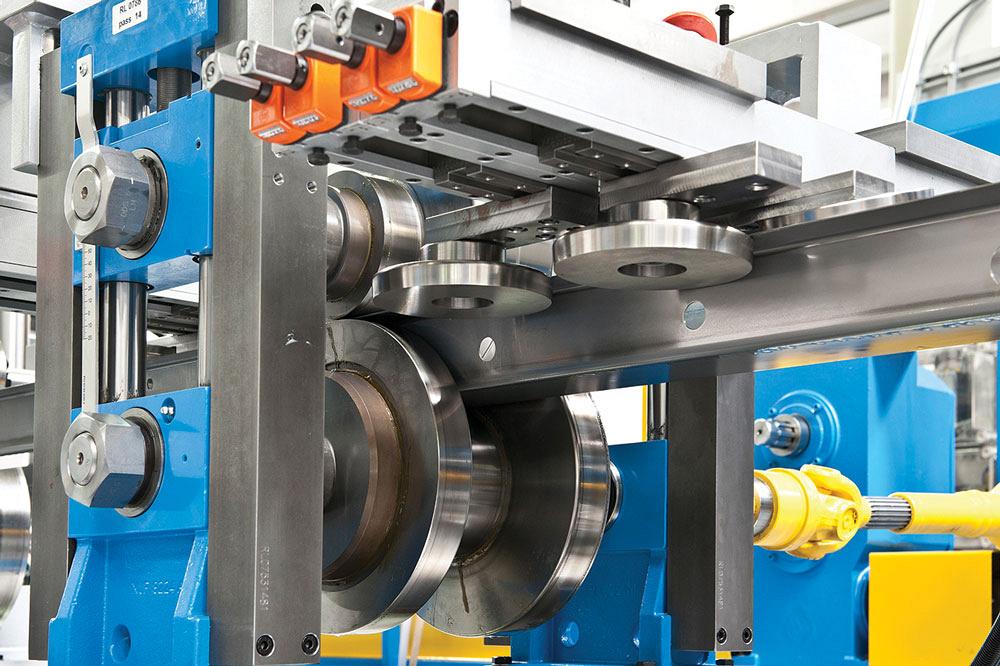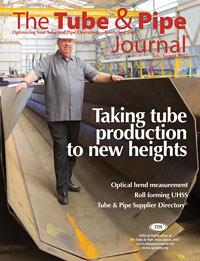Director of Sales
- FMA
- The Fabricator
- FABTECH
- Canadian Metalworking
Categories
- Additive Manufacturing
- Aluminum Welding
- Arc Welding
- Assembly and Joining
- Automation and Robotics
- Bending and Forming
- Consumables
- Cutting and Weld Prep
- Electric Vehicles
- En Español
- Finishing
- Hydroforming
- Laser Cutting
- Laser Welding
- Machining
- Manufacturing Software
- Materials Handling
- Metals/Materials
- Oxyfuel Cutting
- Plasma Cutting
- Power Tools
- Punching and Other Holemaking
- Roll Forming
- Safety
- Sawing
- Shearing
- Shop Management
- Testing and Measuring
- Tube and Pipe Fabrication
- Tube and Pipe Production
- Waterjet Cutting
Industry Directory
Webcasts
Podcasts
FAB 40
Advertise
Subscribe
Account Login
Search
Roll forming continues to cut weight, cost for automotive applications
Process handles UHSS, contributes to mass production of individualized components
- By Heinrich Weber
- July 24, 2017
- Article
- Roll Forming
Simultaneous weight reduction and cost reduction is one of the most important development targets in the automotive industry. Part designers have been substituting specialty materials for conventional steel for years, in some cases using ultrahigh-strength steels (UHSS), materials that have tensile strengths up to 232,000 pounds per square inch (PSI). Such steels already contribute to the considerably reduced weight of today’s vehicles, and some automotive experts have calculated a further weight reduction potential by an extended use of UHSS of up to 20 percent. While some metals and plastics have substantially better strength-to-weight ratios than many UHSS, weight reduction achieved with these materials usually is offset by higher cost.
Forming UHSS can be a significant challenge. Most automotive body parts are produced by cold stamping on presses. The maximum tensile strength that can be processed economically by cold stamping typically is 116,000 to 145,000 PSI. Higher tensile strengths, up to 232,000 PSI, can be formed by hot stamping, also known as press hardening. Compared to roll forming, hot stamping offers almost unlimited 3-D forming capability. However, the higher process cost of hot stamping results in a cost difference of approximately $2 for a part that typically is roll formed, such as a rocker panel (see Figure 1). Whether the stamping process is cold or hot, a stamping die is designed for one specific part, and the cost usually is substantial.
Roll forming technology can help reduce weight and cost. It has demonstrated its capability to process UHSS with a tensile strength up to 232,000 PSI. Over the years, roll forming has taken on an increasing role in the automotive industry in many cases making parts that formerly were stamped.
Making Consistent Parts from Varying Material
Today rockers, bumpers, door beams, crash tubes, and other UHSS parts are manufactured economically on roll forming systems. The strength of the material is not challenging for a roll forming machine as long as the processing steps were developed to handle the higher forming forces. Even tooling wear isn’t a significant issue. In some cases, after producing several million UHSS parts, the tooling shows little wear because of the minimal speed differential between the forming rollers and the material being formed.
The big challenge in using roll forming to make parts from UHSS is in dealing with fluctuations in mechanical properties and, often, poor flatness.
One method to deal with this is controlled bending, which guides the material by rollers from both sides during the entire forming process. This process compensates for quality deviations caused by changing material properties. It also eliminates end flare, which is typical for conventional roll forming. The numeric simulation of the forming process and the comparison with measured results have played key roles during the development of controlled bending. As a result, it’s possible to make a rocker panel from a martensitic steel, alloy MW 1500, with a tolerance of ± 0.02 inch in all dimensions consistently.
Piercing and Embossing. In many cases, automotive components have pierced or embossed areas. Consequently, many automotive roll forming lines have punching equipment to punch the material either before or after it is formed.
Since such equipment increases the equipment investment and therefore the part cost, it’s worthwhile to investigate alternative equipment. Using a compact hydraulic punch is one such possibility. A punch that develops up to 225 tons of force, equipped with a hydraulic cylinder that works at 120 strokes a minute, can be a handy alternative to a conventional system. If a specific part design would require a higher press force, two or more of these presses can be installed in the line, one after the other.
Sometimes a punch pattern comprises a constant portion and a variable portion. In such a case, only the tool for the variable portion is exchanged, reducing changeover time and tooling cost. This would not be possible with one big punching die.
Mirrored Parts. Automotive parts frequently have a right- and a left-hand version. While the cross-section remains the same, the punch pattern is reversed left to right and requires two punching dies.

Figure 1
Tight control of the forming process leads to tight tolerances of the finished parts. Modern equipment can achieve tolerances of ± 0.02 in. consistently, in all dimensions, on materials such as MW 1500, which has an ultimate tensile strength of 218,000 PSI.
Because roll forming lines usually process a continuous metal strip, making such parts requires cutting off the strip and removing the punching die laterally, stopping production and wasting some of the material. Using a second die allows a simplified changeover. Instead of exchanging the punching dies laterally, the second die is in waiting position before or after the press. When the change has to be executed, the dies are exchanged by moving them longitudinally. It’s a faster process that eliminates waste.
The press can control up to 21 individual punches, which can be activated at full production speed. This allows flexibility in punch patterns, and if more flexibility is necessary, the press can be transformed into a CNC press by inserting a CNC punching insert (see Figure 2). This is especially useful for low-volume batch production with frequent changeovers.
Roll Forming and Roll Bending. Integrating a bending operation into a roll forming line offers two main advantages. First, it simplifies the process for making parts with a sweep. Offline bending operations require straight ends. Such ends have to be cut off when the part design requires a sweep until the part end. This scrap can be avoided by roll forming.
Bumpers and other automotive components, such as B-pillar covers with a constant radius, are nothing new to roll forming. However, modern automobile designs pose more significant bending challenges, such as parts with at least two radii—a large one in the center of the part, often 80 to 120 in., and smaller bends at the ends, from 16 to 24 in. The conventional bending process doesn’t handle such small bends well. Wrinkles and waves tend to develop in the areas under compression. Newly developed in-line CNC bending equipment can handle such small radii without deformation and adapts to various radii without tool change.
Customized Mass Production
Roll forming has been more than just roll forming for decades, embracing auxiliary processes such as piercing, embossing, welding, and even assembling and packaging. In the past, such lines were dedicated to one product or a small number of specific products. As time goes on and technologies improve, roll forming lines are becoming more versatile, so that one line can produce highly varied parts made to order. One such application is the production of kitchen drawers. The drawer manufacturer makes several size of kitchen drawer on one line, producing parts so they are ready for assembly just-in-sequence. The assembly lines require several product changeovers per day, facilitated in part by the ease of changeover in roll forming tooling.
The same applies in a line that produces high-bay warehouses. The manufacturer has to produce all necessary components of an individual warehouse in the shortest possible time, and the part designs for these components vary substantially. Roll forming’s capabilities and efficiency allow quick changeovers without a time-consuming tool change.
References
R.F. Singer, “Leichtbau ist schwer,” Akademie Aktuell 3, 3/2012.
Taylan Altan and A. Erman Tekkya, eds., Sheet Metal Forming Processes and Applications, (Materials Park, Ohio: ASM Intl., 2012).
About the Author
Heinrich Weber
215-799-0220
About the Publication
Related Companies
subscribe now

The Tube and Pipe Journal became the first magazine dedicated to serving the metal tube and pipe industry in 1990. Today, it remains the only North American publication devoted to this industry, and it has become the most trusted source of information for tube and pipe professionals.
start your free subscription- Stay connected from anywhere

Easily access valuable industry resources now with full access to the digital edition of The Fabricator.

Easily access valuable industry resources now with full access to the digital edition of The Welder.

Easily access valuable industry resources now with full access to the digital edition of The Tube and Pipe Journal.
- Podcasting
- Podcast:
- The Fabricator Podcast
- Published:
- 04/16/2024
- Running Time:
- 63:29
In this episode of The Fabricator Podcast, Caleb Chamberlain, co-founder and CEO of OSH Cut, discusses his company’s...
- Trending Articles
Zekelman Industries to invest $120 million in Arkansas expansion

3D laser tube cutting system available in 3, 4, or 5 kW

Corrosion-inhibiting coating can be peeled off after use

Brushless copper tubing cutter adjusts to ODs up to 2-1/8 in.

HGG Profiling Equipment names area sales manager

- Industry Events
16th Annual Safety Conference
- April 30 - May 1, 2024
- Elgin,
Pipe and Tube Conference
- May 21 - 22, 2024
- Omaha, NE
World-Class Roll Forming Workshop
- June 5 - 6, 2024
- Louisville, KY
Advanced Laser Application Workshop
- June 25 - 27, 2024
- Novi, MI




























